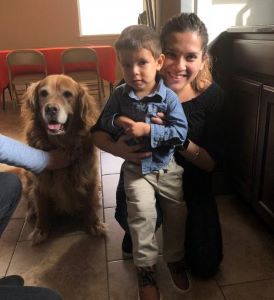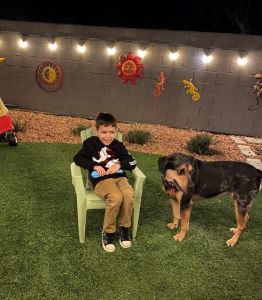
Growing up, I remember asking - almost begging - my parents if we could get a dog. This was something my sister and I always wanted. Fast forward several years, now I am the parent being begged by my two sons (ages 2 and 5) and husband. Even though we have not yet decided, my two sons are often around dogs. At grandma’s house alone, there are four dogs: Molly, Zero, Lilly and Maya.
At first, it will be a period of adjustment. Dogs getting used to having kids around the house and kids getting used to sharing the living room space with the dogs.
This adjustment will take some time and a few family conversations are needed to ensure everyone understands the following:
- Dogs follow children for many reasons. Dogs will follow most anyone with food and little ones can be great sharers and resources for snacks, especially around the dinner table or highchair. Children often have sticky hands and sweets on their face or food smudges on their clothing. This might give you the impression the dogs have a strong bonding relationship with children, when they are only trying to sniff away.
- A child’s voice might bother a dog. Children tend to have high-pitched voices and their yelling may alarm a dog or make them feel threatened.
- Never assume a dog will not bite. Family members might assure you that their dogs will not bite. However, most dog bites happen from a dog known to the child and family.
No matter how friendly you think your dog is, an adult must always be present to help guide child’s interactions. By following these recommendations, you can prevent a dog bite:
- Leaving children unattended is not safe. Always keep young children at arm’s reach. Parents multitask daily life activities (talking on phone, cooking, caring for other children, working, etc.). Injuries can occur in less than 4 minutes. A hug or pat on the head from a child can be taken as an act of aggression by a dog.
- Never let your dog play with children’s toys. Plush and squeaky toys may look the same. If your dog chews and destroys a toy, you may end up with rubbery and plastic pieces that may end up in your child’s mouth and pose as a choking hazard. Keep children’s toys out of reach from dogs.
- Teach children not to play with dogs’ toys. Keep toys separate in different parts of your home. If you see your child playing with your dog’s toys remind your child that it does not belong to them.
- Never let children sit or ride on a dog. It is important to teach children safe petting. When children sit on or ride a dog, the dog may feel threatened and bite a child. Always pet with care and stay away from the face and tail.
- Talk to children to read your dog’s body language. It is important for children to learn pet behaviors and learn to recognize the signs when a dog is friendly, playful, scared, or aggressive. When talking to your children, keep their developmental age in mind.

I know in the future we will be ready to add a sweet dog to our family. For now, we enjoy playing with our four doggy friends at grandma’s house.
To learn more about dog bite prevention, click here.
